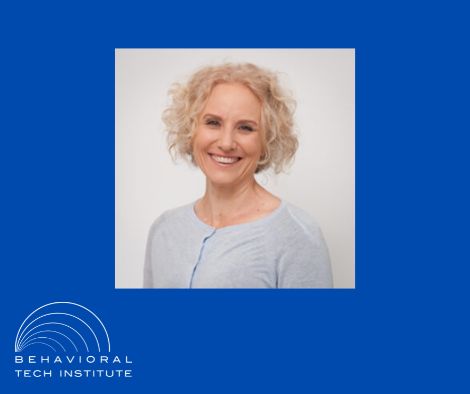Dr. Cooney recorded this casual summary of DBT for Substance Use Disorders, in June of 2025, for participants of the DBT Self-Paced Foundational Training.
Click here to watch the video
_________________________________________________________________________________________________________________________________
I wanted to talk with you about DBT for substance use disorders. And I’m having a thought that substance use is something that comes up with DBT clients, independent of whether they’re in a program that’s specific to substance use disorders or not. And that in some ways, self-harm itself can be seen as something of an addictive behavior where the person often wants to stop and finds themselves continuing despite repeated efforts to avoid it.
So I wanted to talk a little bit about the similarities and differences between programs, DBT programs that are specifically focused on substance use disorders and DBT programs that are standard DBT.
So, what are the main similarities and differences between standard DBT and DBT SUD or DBT for substance use disorders?
Well, a big one is targeting.
So targeting and standard DBT, is life-threatening behavior first in individual sessions, followed by therapy interfering behavior, followed by quality-of-life interfering behavior, followed by increasing skills use.
And for DBT for substance use disorders, the hierarchy is the exact same as the assumption that substance use is the highest, like the top quality of life interfering behavior.
And of course, there are a myriad of ways in which substance use may interfere with therapy as well.
So for example, people might arrive to sessions under the influence.
They might not attend because they’re high and don’t feel like coming.
They may neglect to take replacement medication that is important to them for maintaining abstinence from substances.
But the main kind of assumption is that if you’re working with someone who’s struggling with substance use, that’s going to be the top target in terms of the myriad of behaviors that are interfering with their life.
So that’s number one.
Number two is the seven skills that are specific to substance use disorders.
So they’re called the Skills for When the Crisis is Addiction.
And they are located, the Handouts and Worksheets (Linehan, 2025) for those are located in the back end of the Distress Tolerance module.
And if you look at the curriculums, like, in the chapter that’s dedicated towards describing various curricula for teaching skills, the Skills curriculum that’s specific for a DBT-SUD program recommends having the majority of the skills, the Substance Use Disorder skills, taught after Distress Tolerance or in the distress tolerance module, with the exception of the skills that are referred to as clear mind, clean mind, and addict mind, which are typically taught in the context of when teaching mindfulness, teaching the mindfulness module.
And I realize that the terms addict mind and clean mind are of their time.
So this manual was developed in 2014, well, was published in 2014 and was developed in the years preceding that.
There are multiple people that may find those terms judgmental and ill-fitting for DBT.
And there was a publication in the DBT Bulletin written about this exact issue where (Reuben Hendler) essentially presents the case for having flexibility about using these labels. (Hendler, 2023)
So Clean Mind has been referred to as Naive mind, for example, and addict mind has been referred to as Use mind or Addiction mind.
So don’t feel like you’ve got to be a slave to these labels. You can change them to fit your own purposes and your own worldview about this stuff and what’s effective in your communities.
So, the seven substance use disorder skills, I’m not going to go into them in detail because there are whole chapters referred to them, like describing them.
However, they comprise, basically you can remember them by the acronym D-C-B-A.
And the idea of this is you’re reversing; you’re backing away from substance use.
The first couple of skills are Active Mind, Clean Mind, Clear Mind, and Dialectical Abstinence.
So Dialectical Abstinence is this idea of marrying the goals of DBT, which are essentially about abstaining from the drug, the substance or substances, that are causing you the most problems in your life, while also radically accepting that you are not infallible, that you’re not bulletproof, and that lapses are going to, are likely to, occur.
And so it’s trying to take the best of both worlds, like the best of harm reduction and abstinence, and sort of have your cake and eat it too.
So the benefits of abstinence are that usually people have a longer amount of time actually abstaining from a substance.
The downside of the abstinence model is that when people fall off the wagon, they fall hard and it takes them a long time, or often longer, to get back on the wagon.
So balancing that out from harm reduction, where the focus is on trying to prevent relapses and just trying to limit the harms that substance use can result in.
The benefits of that are that you tend to get back to abstinence faster and you don’t, and the downsides are that you are more frequent in your lapses, that you more frequently fall into relapsing or using substances.
So the idea of Dialectical Abstinence is essentially to be
single-mindedly, one mindfully focused on abstinence and that it’s not an option to use; that failing, like stopping and staining is not possible, is not an option. And that if you lapse, then the idea is to get back into abstinence as quickly as possible.
So it’s sort of like an Olympic athlete, like just aiming for gold, like winning every race, every time, and not sort of allowing the possibility of defeat to enter your mind as you’re about to, as the starting gun is about to go off.
And if you don’t win that race, if you sustain an injury, working to recover and to get back in the race as quickly as possible, like to get back into competing as quickly as possible.
So, the other skills, I’ll just list them out here, are
- Dialectical Abstinence,
- Clear mind,
- Clean mind,
- Addict mind,
- Community reinforcement,
- Adaptive denial,
- Alternate rebellion,
- (Burning) bridges, (Building) new ones.
That might be 7.
And with the exception of Clean mind, Clear minded and Wise mind, all the rest are taught in Distress Tolerance (Linehan, 2025), with the exception of Community Reinforcement, which is about obtaining reinforcement from your community and also reinforcing yourself.
It’s very much an Interpersonal Skill. So, it’s put in the Interpersonal section. (Linehan, 2025)
So that’s how the skills differ.
And then two other big things about DBT for substance use disorders, is that there’s a much greater focus on staying attached because, in general, the research has indicated that using the DBT idea of butterflied patients and attached patients. (Axelrod, 2018 & McMain, Dimeff, Sayrs, Linehan, & Koerner, 2021) Where attached patients show up every session, tend to get upset when their therapist goes on vacation or can’t meet them one week, but show up every time, whether they’re happy or irritated and the MO is to be engaged and attached to the therapist.
In contrast, butterfly patients are ones that sort of flutter in and flutter out, might miss quite a few sessions in a row, and then show up in crisis, where the relationship with the therapist is perhaps not as important as other relationships in their life, like say a relationship with a partner or their relationship with a substance.
And so attached patients normally show up. Attendance isn’t the issue.
It’s figuring out the interpersonal ruptures that can often happen within session.
Butterfly patients tend to not show up and not be in touch as much, use phone coaching less frequently, and just seem less engrossed in therapy.
And therefore, a lot of strategies and DBT for substance use disorders are about increasing and amplifying that attachment.
So right at the beginning of working together, the therapist will be asking the person,
- If you become lost to therapy, how can we find you?
- Who do we need to speak to?
- Who else do we need to involve in this therapy?
- Who’s important in your life?
- What are the places we should go looking for you?
- Can I get permission to go looking in those places, speaking to those people if I’m not hearing from you and you’ve lost several sessions in a row and either your phone’s not working anymore or you’re just not responding to me?
- What’s going to work here?
So we speak explicitly about the butterfly problem and then figure out together how to solve it.
And so as a therapist, you might be in touch a lot more frequently with your client who’s in DBT-SUD.
Just to check in and to maintain this warm engagement rather than every phone call being about phone coaching.
All right; that’s a little taster about DBT for substance use disorders.
I hope you find it useful.
Learn more about the Self-Paced DBT Foundational here: https://behavioraltech.org/dbt-foundational-training/
Would you like to learn more about DBT for Substance Use Disorders?
Check our schedule of upcoming training here: https://behavioraltech.org/upcoming-trainings/
Or send an email to support@behavioraltech.org
References:
Axelrod, S. R. (2018). Dialectical behaviour therapy for substance use disorders. In M. A. Swales (Ed.), The Oxford handbook of dialectical behaviour therapy
(pp. 595–614). Oxford University Press. https://doi.org/10.1093/oxfordhb/9780198758723.013.16 [academic.oup.com]
Hendler, R. (2023, November 16). DBT Bulletin (Vol. 9). Retrieved from:
https://static1.squarespace.com
Linehan, M. M. (2025). DBT Skills Training Manual: Revised Edition. Guilford Press. ISBN: 9781462556359
(https://www.guilford.com/books/DBT-Skills-Training-Manual/Marsha-Linehan/9781462556359)
McMain, S., Dimeff, L. A., Sayrs, J., Linehan, M. M., & Koerner, K. (2021). Dialectical behavior therapy for individuals with BPD and substance dependence. In L. A. Dimeff & S. Rizvi (Eds.), Dialectical behavior therapy in clinical practice: Applications across disorders and settings (2nd ed.). The Guilford Press. (https://www.guilford.com/books/Dialectical-Behavior-Therapy-in-Clinical-Practice/Dimeff-Rizvi-Koerner/9781462552641)
__________________________________________________________________________________________________________________________
Overview
Dr. Cooney provides a casual yet informative overview of how DBT is adapted for clients with substance use disorders. She emphasizes that substance use often arises in DBT settings, even outside of specialized SUD programs, and draws parallels between substance use and self-harm as addictive behaviors.
Key Differences Between Standard DBT and DBT-SUD
- Targeting Hierarchy
- Both approaches prioritize life-threatening behaviors first.
- In DBT-SUD, substance use is considered the top quality-of-life interfering behavior, often impacting therapy attendance and engagement.
- Specialized Skills for Addiction Crises
- DBT-SUD includes seven additional skills, taught primarily in the Distress Tolerance module:
- Dialectical Abstinence
- Clear Mind
- Clean Mind (aka Naive Mind)
- Addict Mind (aka Use Mind or Addiction Mind)
- Community Reinforcement
- Adaptive Denial
- Alternate Rebellion
- Burning Bridges, Building New Ones
- Some skills (e.g., Clean Mind, Clear Mind, Addict Mind) are introduced during Mindfulness training.
- Terminology Sensitivity
- Terms like “Addict Mind” and “Clean Mind” are acknowledged as potentially judgmental. Alternatives such as “Use Mind” and “Naive Mind” are encouraged for flexibility and cultural sensitivity. [SUD Vid tr…script.txt | Word]
Dialectical Abstinence Explained
- A core concept in DBT-SUD, it blends abstinence goals with radical acceptance of lapses.
- Clients are encouraged to aim for abstinence with Olympic-level focus, but to recover quickly if they lapse, integrating principles from both abstinence and harm reduction models.
Attachment and Engagement Strategies
- DBT-SUD places greater emphasis on maintaining therapeutic attachment, especially for “butterfly patients” who are inconsistent in attendance.
- Therapists proactively plan for potential disengagement by:
- Asking clients how they can be reached.
- Involving important people in the client’s life.
- Maintaining warm, frequent contact beyond crisis coaching.
Conclusion
Dr. Cooney concludes by highlighting the importance of flexibility, engagement, and skill adaptation in DBT-SUD. The approach is designed to meet clients where they are, while providing structured tools to support recovery and therapeutic connection.

